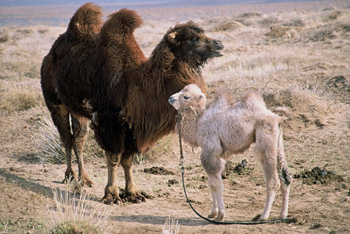![[Metroactive Movies]](/movies/gifs/movies468.gif)
[ Movies Index | Show Times | Santa Cruz Week | SantaCruz Home | Archives ]
Not Necessarily 'Nanook'
Nonfiction, nature and narrative are combined with a poetic sensibility in 'The Story of the Weeping Camel'
By David Fear
Once upon a time, filmmaker Robert Flaherty traveled to Hudson Bay, intent on capturing and preserving the world of the Eskimo on celluloid. Then it was revealed that he hadn't exactly recorded truth 24 frames per second the entire time. For vérité disciples, this was sacrilege. This was not an objective cultural reality, this was dramatized culture--and the two, they said, were mutually exclusive.
The shadow of Flaherty's Nanook of the North looms large over The Story of the Weeping Camel. The film shares Flaherty's fascination with indigenous ways of life, mixes real footage with re-creations of events and employs actual members of these societies to tell their tales.
The similarities, however, end there, as Camel treats nonfiction as just another arrow in its quiver available for scoring bigger-picture bull's-eyes. This film doesn't want to be a documentary so much as to document a landscape, and it doesn't believe that employing other modes of storytelling--a sense of oral history, Nature Channel specials and (gasp!) even fictional narrative--compromises its ability to showcase this society's way of existence.
Based on the memory of a short film that co-director Byambasuren Davaa saw as a child, the movie follows a family of camel herders in the Gobi Desert as they go about their daily routine. Tending to their flock, they discover the mother of one newborn calf won't suckle her baby; the hard labor has apparently produced maternal bitterness in her. So they set out to fetch a musician known for performing a peculiar reuniting ritual: playing a song that can inspire the elder animal to love her progeny and, concurrently, shed some camel tears.
Davaa and her directorial partner-in-crime/fellow film student Luigi Farloni have opted for authenticity over professional actors, employing real-life shepherds and their animals to tell the story and using plenty of you-are-there footage--yes, that is an actual birthing in all its messy placental glory--that recalls those National Geographic ethno-extravaganzas of yesteryear.
Slowed down to the pace of its rural landscapes, the movie maintains a sense of stumbling across these tableaus of life while still keeping viewers enthralled, especially in the climax, where the string player coaxes crying from both the reluctant matriarch and audience members. Considering their natural onscreen charisma, reports of the camels signing with ICM or engaging in talks with Martin Scorsese about future projects wouldn't be surprising. What is startling is how moving the whole affair is and how the whole "live or Memorex" argument of the past is rendered moot. The Story of the Weeping Camel never claims to be the whole truth and nothing but, yet this doesn't detract from the movie's power of authenticity one iota. I'll be damned if a gorgeously poetic sense of this culture's reality doesn't rise up from the soup regardless.
Copyright © Metro Publishing Inc. Maintained by Boulevards New Media.
For more information about Santa Cruz, visit santacruz.com.
![]()

While My Dromedary Gently Weeps: Every day is hump day in 'The Story of the Weeping Camel.'
The Story of the Weeping Camel (PG; 87 min.), directed and written by Byambasuren Davaa and Luigi Farloni, photographed by Falorni and starring Janchiv Ayurzana and Chimed Ohin, opens Friday at the Del Mar in Santa Cruz.
From the June 16-23, 2004 issue of Metro Santa Cruz.